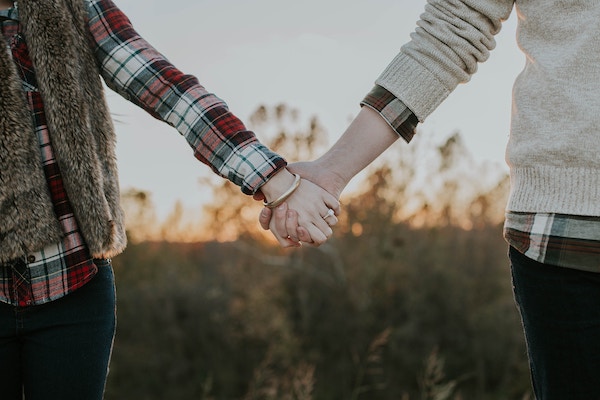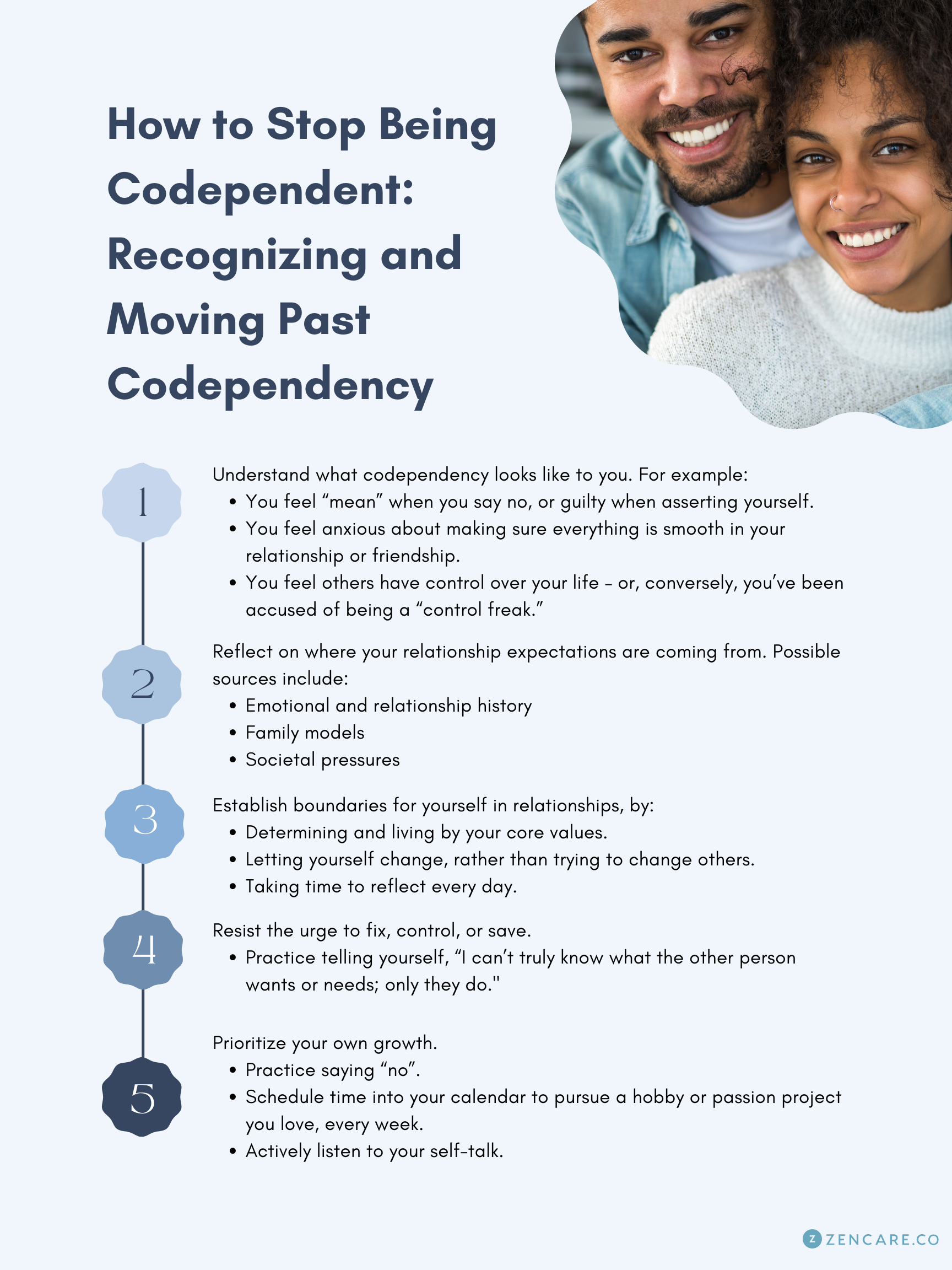Codependency is a two-sided coin of “give” and “take.” One individual tends to fill the caregiver role: They’ll step in and help a loved one who’s experiencing difficulties. This impulse often stems from good intentions — after all, the desire to fulfill emotional needs of others is a strength. But when such actions become the go-to response, or the offered care takes away from other important aspects of life, the dynamic may become more enabling than helpful.
On the other side is the individual receiving this attention. Such a symbiotic dynamic can cause the “care taken” individual to foster reliance — and they may start to fall into a habit of depending on the caregiver to give them a hand.

Although codependency has long been associated with substance abuse and chronic illnesses — e.g., a child caring and taking responsibility for their alcoholic parent — it can apply to other types of relationships as well. A romantic partner, friend, and a family member can all unconsciously fall into patterns of codependent behavior.
The good news is that signs of codependency is something you can identify and overcome to achieve a healthy relationship. Here are 5 steps to help you facilitate positive change and stop being codependent:
1. Understand what codependency looks like to you
The first important step you need to take in order to break away and heal from this cycle of codependency is to understand the unhealthy pattern for yourself. Which side of the coin are you on?
Do you find that your own feelings, your own happiness, or sense of self-worth are defined by your significant other? This might look like having a hard time on the days your partner, family member, or friend is upset. Or do you find yourself resorting to dishonest tactics to avoid confrontation with intimate relationships in your life, perhaps out of fear of retaliation?
Conversely, maybe you have trouble trusting others — which manifests in a compelling need to control and take care of others. You might commonly find yourself saying statements like “I need you to do this now,” even if the situation isn’t entirely dire. Maybe you feel completely responsible for your partner’s dysfunctional pattern of behavior and find yourself repeatedly bailing them out from unfavorable situations.
Both of these scenarios are signs of a codependent relationship Some codependent traits may include:
- Feeling responsible for others’ happiness, actions and emotional well-being
- Confusing pity for love — leading to a tendency to love people whom are perceived as rescuable
- Automatically inclined to do more than one’s own “share” in a relationship, creating an imbalance of power
Some other behaviors displayed by codependent people include:
- You feel guilty asking for your own personal needs, personal interests and setting healthy boundaries
- You feel “mean” when you say no, or guilty when asserting yourself.
- You feel anxious about making sure everything is smooth in your relationship or friendship.
- You feel others have control over your life — or, conversely, you’ve been accused of being a “control freak.”
- You actively feel resentful towards others, especially when they take care of themselves.
- You constantly have pangs of FOMO or feel lonely, unloved, and uncared for.
There’s no right or wrong here and it’s important to acknowledge that none of this is your fault. Codependency is something that builds gradually and reflects our backgrounds, past relationships, and habits. Recognizing that there’s some codependency in your relationship is a crucial first step in identifying your own unhealthy relationship patterns, so you can begin the next step — the healing process that’s necessary to move past them.
2. Figure out where your relationship expectations are coming from
“One challenging aspect of recovery from a codependent relationship is pulling back from blaming the other person for the problems,” says Juliane Maxwald-Schrey, a Licensed Psychoanalyst and Credentialed Alcoholism and Substance Abuse Counselor in Long Island City.
More often than not, it’s never just one person who’s the source of all things difficult dynamics within an interpersonal relationship.
We tend to bring our pasts and memories into our adult relationships, especially if they’re difficult ones. All those past disappointments and resentments can affect how we interact with others.
“Until we can detangle these emotions for ourselves, it will be difficult to grow out of a codependent cycle,” she says.
Spend some time meditating and reflecting on what your family’s relationship expectations were as you were growing into adulthood. For example, what role did your mother play for your father, or what role were you expected to play for your siblings? Understanding where your relationship expectations are coming from can help you identify unhealthy patterns in your current relationships.
Therapy can be a way to dedicate time to understanding these patterns. Unpacking expectations from your upbringing (also known as family of origin) is also the expertise of psychodynamic and psychoanalytic therapists. If you think that your relationship has codependency within it, consider looking for therapists who take these therapy approaches, as a trained professional will help you.

3. Establish boundaries for yourself in relationships
The nature of codependency is such that it tends to blur the lines between where one self begins and another ends.
Those healing from codependent relationships may benefit from developing a stronger sense of self.
The following acts can help you develop stronger boundaries:
- Determine what your core values are. These may include time with family, culture, religion, work, or passion projects. Identifying these, as well as the time you need to allot to them, can help you stay on track with what’s important to you. As a result, your needs won’t get eclipsed by your partner’s values or needs.
- Let yourself change, rather than trying to change others. Remember, the only adult you’re in charge of is yourself — so channel your energy into self-improvement, rather than draining yourself worrying about someone else.
- Take time to reflect every day. Whether it’s sitting in complete silence every night, or musing about the day ahead while you’re in the shower, turning this into a habit will allow you to grow a deeper connection with yourself.
Establishing stronger boundaries can help you say “no” to a friend or partner’s requests. On the flip side, they’ll help your partner understand that just because you are independent doesn’t mean that you don’t love them. It can also help you identify how — and when — to walk away from situations that aren’t healthy for you.
4. Resist the urge to fix, control, or save
Often, codependency feeds off a false sense of control. We may think we know what the other person wants — and that it’s up to us to help them get it.
While there’s nothing wrong with being helpful, doing too much — exhausting our energy in “mind-reading,” and trying to remedy situations before they even happen — may lead to a codependent dynamic. It’s also easy to get stuck in this type of pattern.
If you’re ever stuck in a “fixer” mindset, remind yourself: “I can’t truly know what the other person wants or needs; only they do.” While you can still be compassionate and helpful when someone you love is struggling, you needn’t assume to know what someone needs before they ask.
That’s not to say you can’t be compassionate and helpful when someone you love is struggling. It just means that you needn’t assume to know what someone needs before they ask. Think of this strength as a radio — if you play your helpfulness too loudly, it isn’t as enjoyable as when you hit the perfect volume.
5. Prioritize Your Own Growth
At the end of the day, relationships are meant to complement your already awesome life — not be your entire life.
As Maxwald-Schrey says, “It can help to identify what your unspoken expectations might have been in the relationship, and then to explore where those expectations came from.”
Is there something you were trying to get from the partner, family member, or friend in question that would be better off coming from you instead?
Taking a break from patterns of codependency allows you to channel that time and energy back into yourself. Try the following acts to foster self-growth:
- Practice saying “no” to yourself. Practice makes perfect, even if it’s during alone time. Say “no, thank you!” out loud if you find yourself pulled into social media or habits you’re looking to break away from.
- Schedule time into your calendar to pursue a hobby or passion project you love, every week.
- Actively listen to your self-talk. The next time you catch yourself talking down to yourself, turn that negative thinking into something more positive.
Working with a therapist can help you figure out where your codependent tendencies come from and determine techniques to overcome and heal. Therapists are specially trained to recognize relationship dynamics that are harmful to their clients, and they’ll teach you the skills you need to maintain a healthy balance with your partner. We also make it easy to find therapists who are expertise in relationship help — you can filter our therapist directory by Specialities and find Relationship Issues. From here, view therapist introductory videos or schedule calls with them to start in your mental health journey.
